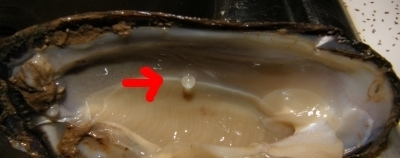 If you work with freshwater mussels, you know that their larval form, known as glochidia, often must live as a parasite in a suitable species of fish to survive. Georgia Department of Natural Resources (DNR) and University of Georgia scientists have discovered that that relationship may work the other way as well: in 2009 DNR zoologist Jason Wisniewski found a developing shad egg inside the shell of a freshwater mussels.
If you work with freshwater mussels, you know that their larval form, known as glochidia, often must live as a parasite in a suitable species of fish to survive. Georgia Department of Natural Resources (DNR) and University of Georgia scientists have discovered that that relationship may work the other way as well: in 2009 DNR zoologist Jason Wisniewski found a developing shad egg inside the shell of a freshwater mussels.
Further research by a group that included Wisniewski and DNR technicians Matt Hill and Deb Weiler revealed that six percent of nearly 760 native mussels sampled from seven sites across more than 150 miles contained one or more fish eggs. The eggs were most commonly found in Altamaha slabshell mussels, which are common in the Altamaha River in Georgia.
Read the Georgia DNR write-up here.
An paper on the surprising find ran in the Transactions of the American Fisheries Society. Read it here.
If you don’t know about the lifecycle of freshwater mussels, learn about it here.
Photo: Altamaha slabshell mussel with American shad egg. Jason Wisniewski/Ga. DNR
